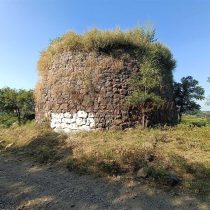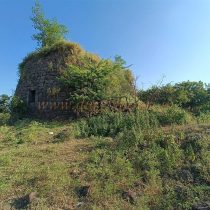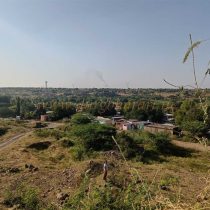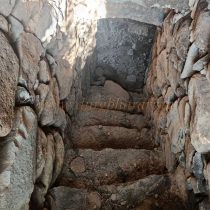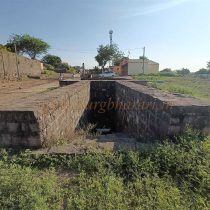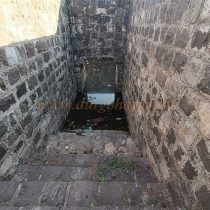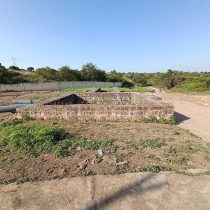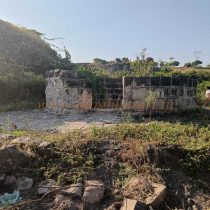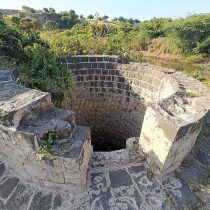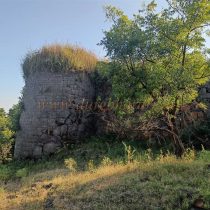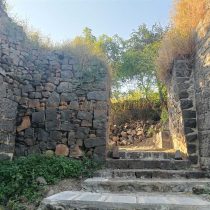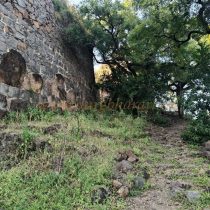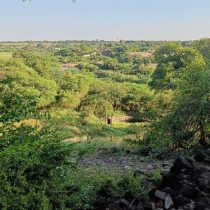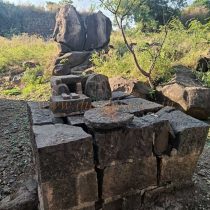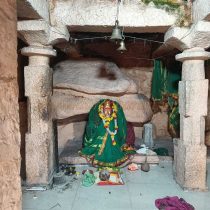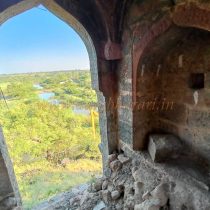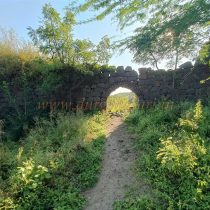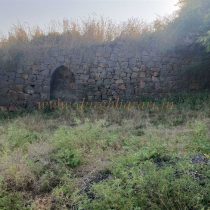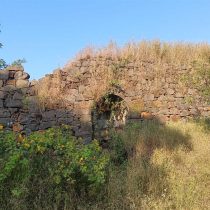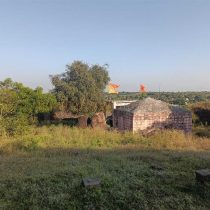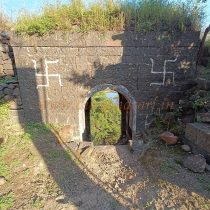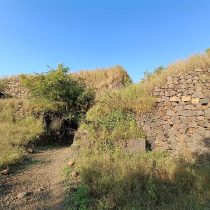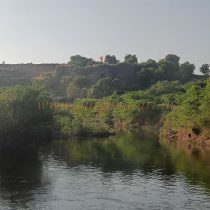ANJANDOH
TYPE : HILL FORT
DISTRICT : SOLAPUR
HEIGHT : 1824 FEET
GRADE : EASY
In the era of Google and the internet, it is quite easy to explore or discover any unknown fort. However, information about some forts may still not be readily available online. Even today, some forts remain completely unknown to the online world. One such fort can be found in the Anjandoh village of the Karmala taluka in the Sholapur district of Maharashtra. Anjandoh, once a historically significant village known as the capital of Karmala taluka in the Sholapur district, is now lost in the abyss of forgetfulness. At a distance of 14 km from the Karmala taluka, Anjandoh is about 145 km from Pune city via Daund Road. Upon entering the village, two bastions located on an elevated platform on the left side of the village entrance and adjacent to the river catch one's attention. The locals tell that there used to be 9 bastions, and there were ramparts surrounding the village.
...
However, direct access to these bastion cannot be seen. On the left side of the village, atop the elevation, there is a bastion that is completely intact, while the other bastion has suffered some damage. Even though the locals suggest that there might be ramparts here, nothing substantial is visible. These bastions are equipped with small windows and a door that leads to the top of the bastion. From there, one can see the entire Anjandoh village, two magnificent houses (wada), a bastion situated on the riverbank, and the Anjandoh Fort. This bastion, standing independently, seems to be a watchtower or a signal tower, designed to keep an eye on the village and the fort. Out of the two bastions, one is in decent condition whereas the other has suffered some damage with time. Even though ramparts could have been built between these bastions, there are no signs of them. There’s a water cistern near these bastions and considering the houses (wada) carved in stone, in the village, we can verify that this place had been the Bajirao Peth as informed by the villagers. The two houses (wada) in the village, belong to Shinde and one of these houses (wada) were built during the British era. The entrance gate has a height of around 15-16 feet. After visiting the village and its artifacts, head towards the fort from the path on the opposite bank of the river. There is a temple near the river but since it’s not reachable during the monsoons, the villagers have constructed a new temple dedicated to the goddesses Dharmabai and Tulabai and their idols have been relocated to the new temple. Within this temple, one can find a staircase leading to the upper part of the fort. From there, the ruins of the fort, along with a picturesque view, become visible. This elevated structure not only offers an impressive view but also serves as a vantage point for observing the fort situated on the opposite side of the river. The main entrance of the fort, located at an elevated position within the ramparts, is not accessible by stairs alone. However, there are two additional gates within the fort for accessing it without climbing. The second gate for entering the fort is situated above this elevated gate. This gate is usually constructed after the completion of the fort, allowing easier access to the temple inside the fort. Passing through the gate onto the fort, you reach the central part of the fort, where the Darmadevi Temple stands on a stone platform amid the fortifications. Above this temple, a stone lamp-pillar is present, and in front of the temple, on the fourth side of the stone platform, is a small temple of Sukhanavati Devi. From here, there is a third small gate for entry into the fort. The fortifications of the fort have been slightly damaged, and in these fortifications, there are five round bastions of a smaller size. On these bastions, there are parapets for firing rifles, but no place for firing cannons. At certain points outside the ramparts, battlements have been constructed to house soldiers. These battlements are meant for the soldiers to stay. The main gate visible from the outside is located on the ground below the elevation of the gate, and there are steps on both sides of the gate for the soldiers to stand for protection. Even though water is not visible on the fort, we can see two soiled tanks fill with mud. The complete fortification is surrounded by a moat. Now, let's delve into the history of the village and the fort. In medieval Maharashtra, the Shinde family was part of the ruling clans. Anjandoh, the ancestral village of Nana Jadhav Shinde, is mentioned in the records of the Shinde family. Nana Jadhav Shinde, an eminent figure of the Shinde family, actively participated in the construction of the Swaraj. The name of Nana Shinde is mentioned in the writings of Krishnaji Anant Sabhasad in "Shivachatrapati's History" on page 81. During the reign of Chhatrapati Rajaram Maharaj, Nana Jadhav Shinde gained prominence. In 1698, with an army of eight thousand soldiers, he entered Khandesh, looting villages such as Nandurbar, Shirpur, Thalner, etc. A prominent officer of the Mughals, Sardar Hussein Ali, was defeated near Thalner, captured, and forced to surrender. In the subsequent years, Rajaram Maharaj led campaigns in Gangathadi, Khandesh, and Vharhad, where Nana Jadhav Shinde was also present. After returning from the campaigns, Rajaram Maharaj appointed a chief in each region, and Nana Jadhav Shinde was appointed in Khandesh. Later, during the reign of Queen Tarabai, crossing the Narmada River, Nana Jadhav Shinde spread the saffron flag over many territories controlled by the Mughals. He constructed his power and fortifications in various regions such as Ujjain, Kalabag, and others in the Malwa region. Nemaji, inspired by the suddenly launched an attack on the enemy and, after a fierce battle, seized treasures from the enemy. Having achieved a resounding victory over the Mughals in Khandesh, Nemaji advanced towards Warhad. According to Mughal reports, Nemaji Shinde entered Warhad with forty thousand infantry and cavalry. The Mughal Subhedar of Warhad, Najib Rustam Khan, led a formidable army against Nemaji. In the intense battle that ensued, Nemaji's forces inflicted a severe defeat on the Mughals. Rustam Khan was wounded and captured while two thousand Mughal soldiers were killed in the conflict. In March 1704, Nemaji launched a surprise attack on the village of Maloda in Malwa, acquiring wealth for the Swaraj. Later, Nemaji Shinde became the Subhedar of Khandesh until Shahu Maharaja’s reign. During Shahu Maharaja’s journey to the south in 1707, Nemaji Shinde was among the first members of the council. Nemaji actively participated in several battles on behalf of Shahu Maharaj. When Shahu Maharaj sought help from Bahadur Shah to overcome the Kambaksh, Nemaji attacked Kambaksh forces near Hyderabad in response to Shahu Maharaja’s orders. In the Battle of Hyderabad, Nemaji successfully climbed the hills near Hyderabad and decisively defeated Kambaksh in 1708. Hussein Ali, the Subedar of Deccan, arrived with reinforcements to help Kambaksh, leading to the Battle of Burhanpur. The fight was intense, but Nemaji Shinde, stationed nearby, influenced the outcome of the battle. Both the Badshah and Hussein sought assistance from the Marathas. In return for their help, Shahu Maharaj demanded the inclusion of Nemaji Shinde in the council. This marked the beginning of Nemaji involvement in the affairs of Khandesh. Further details regarding Nemaji Shinde service and the assistance provided by the Marathas are mentioned in a letter written by Thorale Bajirao to Jivau Shinde. This historical document highlights Nemaji Shinde significant contributions to the Maratha Kingdom, and Mahipatrao Shinde also emphasized the need for continued service.
© Suresh Nimbalkar

